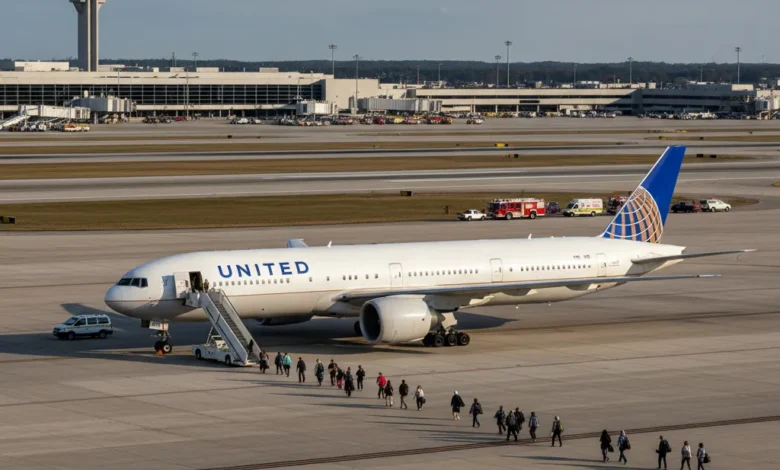United Airlines Flight UA770 Emergency Diversion: What Really Happened?

When news broke about the United Airlines Flight UA770 emergency diversion, it quickly caught the attention of travelers and aviation experts alike. What was supposed to be a routine trip turned into an unexpected test of the airline’s safety protocols and crew preparedness. While diversions like this are rare, they serve as a powerful reminder of how modern aviation prioritizes safety over everything else. For the passengers on board, the experience was disruptive—but for the industry, it was proof that when challenges arise, the system is ready to respond.
Table of contents
- Why did Flight UA770 need an emergency diversion?
- How does an emergency diversion work in practice?
- Key Reasons for an Emergency Diversion
- What does this mean for passengers on board?
- Why is the emergency diversion of UA770 important today?
- How common are diversions like this?
- What lessons can travelers take from UA770’s diversion?
- The Broader Impact of Flight UA770’s Diversion
- How did United Airlines handle the aftermath?
- Could the diversion have been avoided?
- What should future passengers know about diversions?
- Conclusion
- FAQs
Why did Flight UA770 need an emergency diversion?
Airline diversions generally occur for a few key reasons: medical emergencies, technical malfunctions, severe weather, or security concerns. In the case of United Airlines Flight UA770, reports point to a situation that required immediate attention in the interest of passenger and crew safety. While not every detail is always released, airlines typically act quickly to mitigate risks. Safety comes before convenience, and UA770’s crew followed that principle to the letter.
How does an emergency diversion work in practice?
Picture this: the pilot receives an alert or identifies a problem mid-flight. Immediately, the flight deck team communicates with air traffic control (ATC). ATC then coordinates with the nearest suitable airport to clear airspace and prepare emergency response teams. Onboard, cabin crew inform passengers, secure the cabin, and prepare for landing. For Flight UA770, this process meant rerouting the aircraft swiftly, ensuring both passengers and ground teams were ready for an unplanned arrival.
Key Reasons for an Emergency Diversion
When we talk about incidents like United Airlines Flight UA770 emergency diversion, several potential triggers come to mind. Here are the most common reasons flights are forced to reroute:
- Medical Emergencies: When a passenger or crew member requires urgent care.
- Technical Malfunctions: Unexpected mechanical or system issues that demand immediate attention.
- Weather Hazards: Severe turbulence, storms, or unexpected poor visibility.
- Security Concerns: Threats or suspicious activities onboard.
- Airport Issues: Runway closures or airspace congestion.
Each of these factors highlights why UA770’s decision to divert was both prudent and necessary.
What does this mean for passengers on board?
If you’ve never been on a diverted flight, it can feel unsettling. On United Airlines Flight UA770, passengers experienced the unexpected landing, followed by waiting while the airline managed logistics. This could involve medical assistance, mechanical checks, or even transferring passengers to a different aircraft. Though disruptive, diversions are handled with precision. Airlines like United provide updates, arrange alternative connections, and often offer care during delays.
You also might like this: Milyom Travel Guide
Why is the emergency diversion of UA770 important today?
The UA770 diversion isn’t just an isolated incident it highlights modern aviation’s strength. Every commercial airline has strict safety protocols, but when these protocols are tested, we see how effective they are. In an era where travelers expect speed and efficiency, it’s reassuring to know that safety will always override punctuality. The UA770 incident underscores the expertise of pilots, the coordination of ATC, and the importance of airline preparedness.
How common are diversions like this?
Emergency diversions, including those like United Airlines Flight UA770, are relatively rare compared to the millions of flights completed safely every year. Industry data suggests that diversions occur in less than 1% of flights. Yet when they do, they often become newsworthy because of their unexpected nature. While the majority of diversions are precautionary rather than catastrophic, they serve as a reminder that aviation is an industry where preparedness never sleeps.
What lessons can travelers take from UA770’s diversion?
Travelers often worry about delays and disruptions, but UA770 demonstrates a key lesson: the inconvenience of a diversion pales in comparison to the assurance of safety. As a passenger, the best response is trust—trust in the airline’s processes, trust in the crew’s training, and trust in the aviation system as a whole. Flight UA770’s emergency diversion shows that when faced with unexpected issues, the system works exactly as designed.
The Broader Impact of Flight UA770’s Diversion
Impact on Passengers
For those onboard, diversions often mean unexpected stress, delays, and logistical challenges. Passengers on Flight UA770 likely had to adjust travel plans, rebook flights, and deal with the uncertainty of waiting at a different airport.
Impact on Airline Operations
United Airlines faced additional costs from fuel, rerouting, customer support, and aircraft inspection. But beyond money, the airline also had to manage public perception, showing transparency and accountability after UA770’s diversion.
Impact on Aviation Safety Protocols
Every diversion is treated as a case study. Flight UA770’s event will be analyzed by regulators and the airline to refine safety responses, improve communication with passengers, and streamline coordination with ground teams.
How did United Airlines handle the aftermath?
Following the diversion, United Airlines focused on two priorities: supporting the passengers and resolving the underlying issue. That meant ensuring medical or technical concerns were addressed and arranging onward travel. Airlines also conduct post-event reviews, where teams analyze the response to see what can be improved. UA770’s diversion was not just a test for the flight crew but also for the airline’s broader customer service and crisis management systems.
Could the diversion have been avoided?
It’s natural to wonder whether UA770’s diversion could have been prevented. The reality is that aviation is built on redundancy and prevention. Planes undergo rigorous checks before departure. Yet, no system is flawless. When something unexpected arises mid-air, a diversion is the safest choice. In this sense, avoidance isn’t the goal—swift, safe resolution is.
What should future passengers know about diversions?
If you ever find yourself on a flight like United Airlines Flight UA770 during an emergency diversion, here’s what helps: stay calm, listen to crew instructions, and understand that diversions are a safety-first decision. Most diversions end with passengers safely continuing their journeys, sometimes just a little later than expected.
Conclusion
Talking about United Airlines Flight UA770 emergency diversion is really talking about modern aviation itself. While the story begins with disruption, it ends with reassurance—reassurance that the aviation industry is built to handle the unexpected. For passengers, the experience may have been stressful, but the system proved itself. Safety wasn’t just promised; it was delivered. And in a world where efficiency often competes with safety, UA770 reminds us which one truly comes first.
FAQs
Q1: What caused United Airlines Flight UA770 emergency diversion?
UA770 was diverted due to a situation requiring immediate attention, likely a technical or medical issue. The exact cause wasn’t fully disclosed, but safety was the top priority.
Q2: Was anyone hurt during the UA770 diversion?
Reports indicate that all passengers and crew landed safely. Diversions are precautionary and designed to minimize risk, which was the case with Flight UA770.
Q3: How did passengers continue their journey after the diversion?
After landing, United Airlines arranged care and onward connections. Passengers were either rebooked or transported on another aircraft to complete their trips.
Q4: Do diversions like UA770 happen often with United Airlines?
Not frequently. Emergency diversions across all airlines, including United, occur in less than 1% of flights. UA770’s incident was unusual but handled professionally.
Q5: What should I do if my flight faces an emergency diversion like UA770?
Stay calm, follow crew instructions, and trust the airline’s procedures. Diversions, like UA770’s, are designed to protect passengers, not inconvenience them.





